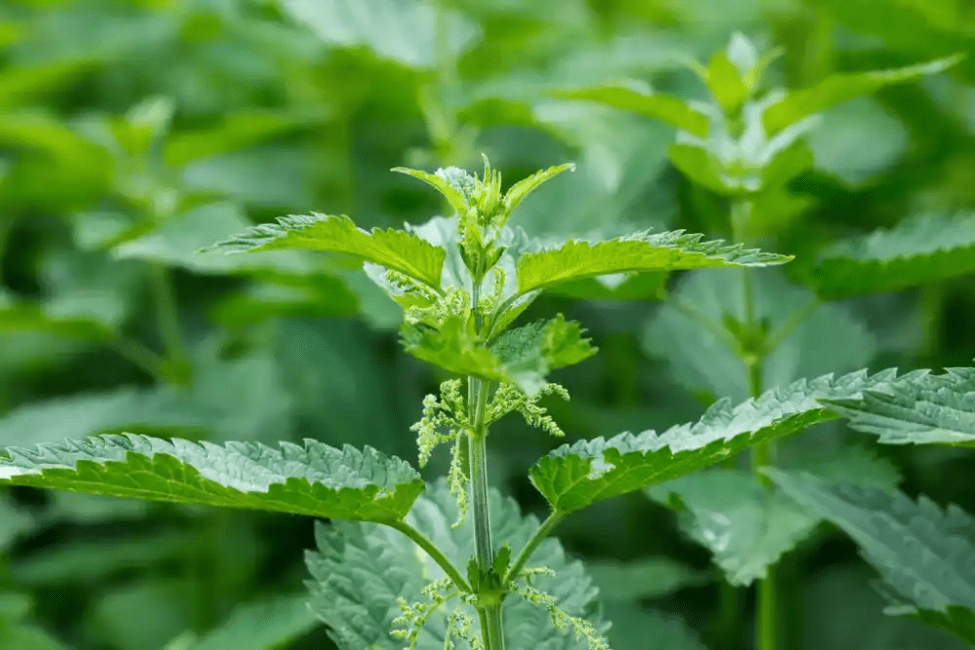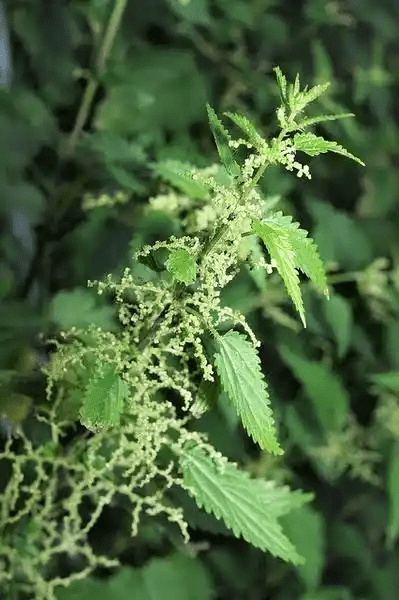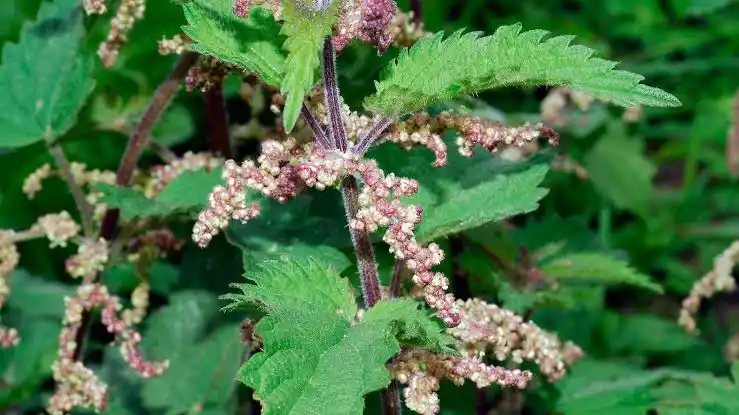Urtica dioica, commonly known as Stinging Nettle, is a versatile and widespread flowering plant belonging to the Urticaceae family. This herbaceous perennial is well-known for its stinging hairs, which can cause skin irritation upon contact.
Despite its somewhat intimidating feature, Stinging Nettle has a rich history of uses, ranging from traditional medicine to culinary applications.
Stinging Nettle typically grows to a height of 1 to 2 meters. The plant has opposite leaves that are serrated and heart-shaped at the base. The stems and leaves are covered with tiny, stinging hairs, which contain irritants that can cause a stinging sensation when touched.
The flowers of Stinging Nettle are typically inconspicuous and greenish. They form in clusters and are arranged in elongated panicles. The plant is dioecious, meaning individual plants are either male or female.
Stinging Nettle is a highly adaptable plant that can be found in a variety of habitats, including meadows, woodlands, and disturbed areas.
It is native to Europe, Asia, North Africa, and North America. Due to its hardiness, it has become naturalized in many other regions around the world.
The stinging hairs on Stinging Nettle contain histamines, formic acid, and other irritants. When touched, these hairs break and release the irritants, causing a stinging or burning sensation on the skin.
While the sting can be unpleasant, it is usually not dangerous and can be alleviated with appropriate treatment.
Stinging Nettle has a long history of use in traditional medicine. The plant is rich in nutrients, including vitamins (such as A and C), minerals (such as iron and calcium), and other bioactive compounds.
It has been used to treat various ailments, including arthritis, allergies, and as a diuretic. Some people also apply crushed nettle leaves to the skin to relieve joint pain.
Despite its stinging hairs, Stinging Nettle is edible and has culinary uses. The young leaves can be harvested and cooked to neutralize the stinging hairs, making them safe to eat. Nettles are used in soups, teas, and as a nutritious leafy green vegetable.
Stinging Nettle plays a role in supporting biodiversity. It serves as a host plant for the larvae of certain butterflies, providing essential food sources for these insects.
In addition to traditional uses, Stinging Nettle has attracted attention in modern research. Some studies suggest potential anti-inflammatory and antioxidant properties, which may contribute to its traditional use for conditions like arthritis.
Urtica dioica, or Stinging Nettle, is a plant with a dual nature – its stinging hairs can cause discomfort, but it also holds nutritional and potential medicinal value. Its ability to thrive in diverse habitats and its historical significance in various cultures make it a noteworthy and multifaceted plant.
The Botanical Description of Urtica dioica
1. Appearance and Growth: Urtica dioica, commonly known as stinging nettle, is a perennial herbaceous plant with a distinctive appearance. It features serrated, heart-shaped leaves with fine hairs on the surface. The plant typically grows to a height of 2 to 4 feet, forming dense clusters.
2. Stinging Mechanism: One of the most notable characteristics of Urtica dioica is its stinging hairs, which release irritating substances upon contact. These hairs inject histamines and other chemicals, causing a stinging sensation on the skin. Despite this, the plant is widely revered for its medicinal and nutritional value.
3. Root System: Below the ground, Urtica dioica boasts an extensive and robust root system. The roots delve deep into the soil, contributing to the plant’s ability to thrive in a variety of environments.
4. Flowering and Reproduction: In late spring to early summer, Urtica dioica produces inconspicuous greenish-white flowers arranged in elongated clusters. The plant follows a dioecious reproductive system, meaning male and female flowers are found on separate plants. This unique feature adds to the plant’s botanical intrigue.
5. Adaptability: Urtica dioica is renowned for its adaptability and resilience. It flourishes in diverse habitats, from woodlands and meadows to disturbed areas and gardens. Its ability to grow in different soil types contributes to its widespread presence in various ecosystems.
The Geographic Distribution of Urtica dioica
1. Native Regions: Urtica dioica is native to Europe, Asia, and North Africa. It has established itself as a prominent plant in these regions, with historical uses dating back centuries.
2. Global Spread: Over time, Urtica dioica has transcended its native regions and spread across the globe. It is now found in North America, South America, Australia, and parts of Asia, thriving in both temperate and tropical climates.
3. Preferred Environments: While adaptable, stinging nettle thrives in environments with moist soil and partial shade. It can be found along riverbanks, in meadows, and near human settlements.
4. Invasive Nature: In some regions, Urtica dioica is considered invasive due to its ability to spread rapidly and dominate certain ecosystems. Despite this classification, its value in traditional medicine and as a nutritious food source has led to intentional cultivation in various parts of the world.
5. Human Interaction: The widespread distribution of Urtica dioica is, in part, a result of human interaction. As a plant with both medicinal and culinary uses, it has been intentionally introduced and cultivated by communities seeking to harness its benefits.
The Chemical Composition Of Urtica dioica
1. Nutrient-Rich Leaves: The leaves of Urtica dioica are a nutritional powerhouse, containing a rich array of vitamins and minerals. These include vitamins A, C, and K, as well as essential minerals like iron, calcium, and magnesium.
2. Phytochemicals and Flavonoids: Urtica dioica is abundant in phytochemicals and flavonoids, contributing to its antioxidant properties. These compounds play a crucial role in neutralizing free radicals and supporting overall health.
3. Amino Acids: Stinging nettle is recognized for its amino acid content, including essential amino acids that the human body cannot produce. This makes it a valuable addition to vegetarian and vegan diets.
4. Lignans and Sterols: The plant contains lignans and sterols, which have been studied for their potential anti-inflammatory and immune-modulating effects. These compounds add to the diverse pharmacological profile of Urtica dioica.
5. High Chlorophyll Content: Urtica dioica owes its vibrant green hue to its high chlorophyll content. Chlorophyll is not only responsible for the plant’s color but also contributes to its potential detoxifying properties.
The botanical description, geographic distribution, and chemical composition of Urtica dioica unveil a plant of remarkable versatility and significance.
From its distinct appearance to its global presence and nutritional richness, stinging nettle continues to captivate the interest of botanists, herbalists, and health enthusiasts alike.
Read Also: How to Farm and Care for Bighead Carp Fish (Hypophthalmichthys nobilis)
The Medicinal Health Benefits Of Urtica dioica (Stinging Nettle)

1. Rich Nutritional Profile: Urtica dioica, commonly known as stinging nettle, is a treasure trove of essential nutrients. Its leaves are packed with vitamins, including A, C, and K, and minerals like iron and calcium. This nutritional richness contributes to its reputation as a health-boosting plant.
2. Anti-Inflammatory Properties: Stinging nettle has been recognized for its anti-inflammatory properties, attributed to compounds such as lignans and flavonoids. These properties make it a potential ally in managing inflammatory conditions like arthritis.
3. Allergy Relief: Surprisingly, despite its stinging hairs, Urtica dioica has been used traditionally for allergy relief. Some individuals find relief from hay fever and seasonal allergies by consuming preparations made from the plant.
4. Joint and Muscle Support: The plant is often employed to support joint and muscle health. Its potential to alleviate conditions associated with inflammation, such as arthritis, has led to its inclusion in herbal remedies for joint discomfort.
5. Blood Sugar Regulation: Research suggests that Urtica dioica may play a role in regulating blood sugar levels. This makes it a subject of interest in the context of diabetes management, although consultation with healthcare professionals is crucial.
6. Support for Benign Prostatic Hyperplasia (BPH): In men, Urtica dioica has been explored for its potential in managing symptoms related to benign prostatic hyperplasia. Compounds in the plant may exert a positive influence on prostate health.
7. Kidney Health: Stinging nettle has diuretic properties that may support kidney health. It is believed to help flush out toxins from the body, promoting a healthy urinary system.
8. Skin Conditions: External applications of Urtica dioica, such as creams or ointments, are utilized for various skin conditions. Its anti-inflammatory and soothing properties may provide relief from conditions like eczema.
9. Boosted Immune System: The plant is known to have immunomodulatory effects, potentially enhancing the overall function of the immune system. Regular consumption may contribute to better immune health.
10. Respiratory Health: Some traditional uses of stinging nettle involve respiratory health. It is believed to help with conditions like asthma and coughs, showcasing its diverse range of potential health benefits.
The Methods of Usage to Achieve the Provided Health Benefits Of Urtica dioica (Stinging Nettle)
1. Tea Infusions: One of the most common methods of using Urtica dioica is by preparing tea infusions. Steeping the leaves in hot water allows the extraction of beneficial compounds, making it a convenient and palatable way to enjoy the plant’s benefits.
2. Dietary Supplements: For those who may not prefer the taste of nettle tea, dietary supplements in the form of capsules or tinctures are available. These supplements provide a concentrated dose of the plant’s active constituents.
3. Topical Applications: External applications, such as creams or salves containing Urtica dioica extracts, are used for skin conditions and joint discomfort. Applying these formulations allows for targeted relief.
4. Culinary Use: Young nettle leaves are edible and can be incorporated into various culinary preparations. From soups to smoothies, adding nettle leaves to your diet provides a nutritional boost.
5. Traditional Tinctures: Traditional tinctures involve steeping Urtica dioica in alcohol or glycerin to extract its medicinal properties. These tinctures are then consumed in small doses for various health benefits.
6. Soups and Stews: In some cultures, stinging nettle is used in soups and stews, offering a unique flavor along with its nutritional benefits. Cooking is believed to neutralize the stinging hairs, making it safe for consumption.
7. Steam Inhalation: For respiratory benefits, inhaling steam infused with Urtica dioica can be beneficial. This method is often employed for managing conditions like nasal congestion and respiratory discomfort.
8. Infused Oils: Creating infused oils by steeping nettle leaves in carrier oils is a method for obtaining the plant’s benefits for skin health. These oils can be used in massages or as part of a skincare routine.
The Side Effects Of Using Urtica dioica Medicinal Plant
1. Allergic Reactions: Despite its medicinal benefits, some individuals may experience allergic reactions to Urtica dioica. Skin irritation, redness, or itching can occur upon contact, emphasizing the importance of conducting patch tests.
2. Interaction with Medications: Urtica dioica may interact with certain medications, particularly those affecting blood clotting or blood pressure. Individuals on medications should consult healthcare professionals before incorporating stinging nettle into their routine.
3. Gastrointestinal Discomfort: In some cases, consumption of Urtica dioica may lead to gastrointestinal discomfort such as nausea or stomach upset. Moderation is key to avoid such side effects.
4. Pregnancy and Breastfeeding: Pregnant and breastfeeding individuals should exercise caution with Urtica dioica, as its effects during these periods are not well-documented. Professional guidance is recommended.
5. Blood Sugar Regulation: While Urtica dioica may aid in blood sugar regulation, individuals with diabetes should monitor their levels closely, as it can interact with diabetes medications.
6. Blood Pressure Effects: Stinging nettle may have effects on blood pressure, and individuals with blood pressure concerns should monitor their levels regularly. Healthcare professional consultation is advised.
7. Diuretic Effects: The diuretic properties of Urtica dioica may lead to increased urine production. Individuals on diuretic medications or with kidney issues should be mindful of potential interactions.
8. Potential Interactions with Lithium: Urtica dioica may interact with lithium, a medication commonly used to treat bipolar disorder. It is crucial for individuals on lithium therapy to consult healthcare professionals before using stinging nettle.
While Urtica dioica offers a plethora of medicinal benefits, it is essential to approach its usage with awareness and caution. Understanding the methods of usage and potential side effects ensures a balanced and informed integration of this remarkable plant into one’s health and wellness journey.
Read Also: The Benefits of Farm-To-Table and Local Food Movements
The Scientific Research and Studies of Urtica dioica (Stinging Nettle)

1. Anti-Inflammatory Properties: Numerous scientific studies have delved into the anti-inflammatory potential of Urtica dioica. The plant contains compounds like quercetin and kaempferol, which have been investigated for their ability to modulate inflammatory pathways in the body. Research suggests that these compounds may provide relief for conditions characterized by chronic inflammation, such as arthritis.
2. Immune-Modulating Effects: Scientific exploration has uncovered the immune-modulating effects of Urtica dioica. Certain compounds in the plant, including lectins, may influence immune responses. While more research is needed to fully understand the extent of these effects, preliminary studies suggest a potential role in supporting immune system function.
3. Antioxidant Properties: Antioxidants play a crucial role in neutralizing free radicals, and Urtica dioica is rich in these beneficial compounds. Scientific studies have investigated the plant’s antioxidant capacity, highlighting its potential to combat oxidative stress and contribute to overall cellular health.
4. Potential for Managing Allergies: Contrary to its stinging nature, Urtica dioica has been studied for its potential to alleviate allergic reactions. Research suggests that the plant may interfere with histamine receptors, offering relief for individuals dealing with allergies. This intriguing aspect has sparked further interest in its application for allergic conditions.
5. Prostate Health: Several scientific studies have explored the effects of Urtica dioica on prostate health, particularly in the context of benign prostatic hyperplasia (BPH). Compounds in the plant, such as beta-sitosterol, have demonstrated potential in improving urinary symptoms associated with BPH, showcasing its significance in men’s health.
6. Blood Sugar Regulation: Scientific research has delved into the impact of Urtica dioica on blood sugar levels. Some studies suggest that the plant may have a hypoglycemic effect, making it a subject of interest for individuals managing diabetes. However, comprehensive studies are necessary to establish clear guidelines for its use in diabetes management.
The Safety Precautions and Recommendations In Using Urtica dioica (Stinging Nettle) Medicinal Plant
1. Allergic Reactions: One of the primary safety considerations with Urtica dioica is the potential for allergic reactions. The stinging hairs on the plant can cause skin irritation, and individuals with known allergies to the plant or similar substances should exercise caution. Conducting a patch test before widespread use is advisable.
2. Interaction with Medications: Individuals taking medications, especially those affecting blood clotting or blood pressure, should consult healthcare professionals before incorporating Urtica dioica into their routine. The plant may interact with certain medications, emphasizing the importance of professional guidance.
3. Pregnancy and Breastfeeding: Limited information is available regarding the safety of Urtica dioica during pregnancy and breastfeeding. Pregnant and breastfeeding individuals should exercise caution and consult healthcare professionals before using the plant for medicinal purposes.
4. Gastrointestinal Sensitivity: In some cases, consumption of Urtica dioica may lead to gastrointestinal discomfort, such as nausea or stomach upset. It is advisable to start with small doses to assess individual tolerance and avoid excessive intake.
5. Blood Sugar Monitoring: Given the potential effects on blood sugar levels, individuals with diabetes should monitor their blood sugar closely when using Urtica dioica. Healthcare professional consultation is essential to determine appropriate dosage and ensure safe integration.
6. Blood Pressure Effects: Urtica dioica may influence blood pressure, and individuals with blood pressure concerns should monitor their levels regularly. Professional guidance is recommended, especially for those on medications for hypertension.
7. Kidney Conditions: Individuals with kidney issues or on diuretic medications should exercise caution with Urtica dioica, as the plant has diuretic properties that may impact kidney function. Regular monitoring and healthcare professional consultation are crucial.
FAQs About Urtica dioica (Stinging Nettle) Medicinal Plant
1. Can stinging nettle be consumed daily for its health benefits?
Yes, stinging nettle can be consumed daily, but moderation is key. Starting with small doses and gradually increasing is advisable to assess individual tolerance.
2. Is it safe to use stinging nettle during pregnancy?
Pregnant individuals should consult healthcare professionals before using stinging nettle medicinally. Limited information is available regarding its safety during pregnancy.
3. How can stinging nettle be used topically for skin conditions?
For topical use, stinging nettle extracts can be incorporated into creams or ointments. Applying these formulations to affected areas may provide relief for various skin conditions.
4. Are there any age restrictions for using stinging nettle for health benefits?
While generally considered safe for adults, it is advisable to consult healthcare professionals for specific recommendations for children, the elderly, or individuals with underlying health conditions.
5. Can stinging nettle interact with medications?
Yes, stinging nettle may interact with certain medications, particularly those affecting blood clotting or blood pressure. Consultation with healthcare professionals is essential for individuals on medications.
Understanding the scientific research, safety precautions, and frequently asked questions about Urtica dioica enhances informed and responsible utilization of this medicinal plant.
Read Also: Economic Importance of Fish and Fish Products

